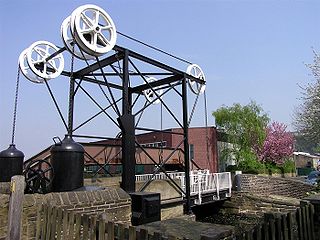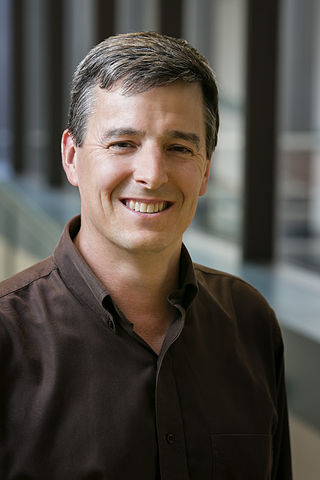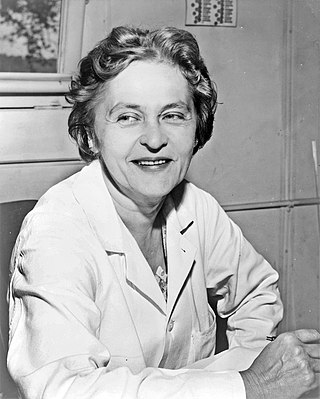
Nathan "Nate" Ball is an American mechanical engineer, entrepreneur, TV host, children's author, pole vaulter, and beatboxer.

Nathan "Nate" Ball is an American mechanical engineer, entrepreneur, TV host, children's author, pole vaulter, and beatboxer.
He was born on May 13, 1983, and grew up in Newport, Oregon. He moved to Boston in 2001 to attend the Massachusetts Institute of Technology, where he studied mechanical engineering and earned two degrees: a Bachelor of Science (2005) and a Master of Science (2007). At MIT he was a two-time NCAA All-American pole-vaulter with a personal record of 16' 8+3⁄4". [1]
Ball has served as a host on the PBS Kids show Design Squad since its first aired in 2007. Ball has also appeared in an episode of MythBusters , a History Channel special on Batman technology, an insurance advertisement, and in a Fetch! with Ruff Ruffman season 4 episode. Ball was featured in the Nova episode The Secret Life of Scientists and Engineers. [2] He is the author of the Alien in my Pocket series of science-adventure chapter books for kids. [3]
In 2005 he co-founded a business to develop the Atlas Powered Ascender, [4] a tool he helped create that enables "reverse rappelling" up vertical surfaces at high speed. [5] He was awarded the Lemelson-MIT Prize in 2007 for his work on the Atlas Powered Ascender, [6] an improved needle-free jet injector system, and his work in engineering outreach with children. He is listed as the co-inventor on six patent applications, including for the Powered Rope Ascender. [7] <

Dean Lawrence Kamen is an American engineer, inventor, and businessman. He is known for his invention of the Segway and iBOT, as well as founding the non-profit organization FIRST with Woodie Flowers. Kamen holds over 1,000 patents.
The Lemelson–MIT Program awards several prizes yearly to inventors in the United States. The largest is the Lemelson–MIT Prize which was endowed in 1994 by Jerome H. Lemelson, funded by the Lemelson Foundation, and is administered through the School of Engineering at the Massachusetts Institute of Technology. The winner receives $500,000, making it the largest cash prize for invention in the U.S.

The windlass is an apparatus for moving heavy weights. Typically, a windlass consists of a horizontal cylinder (barrel), which is rotated by the turn of a crank or belt. A winch is affixed to one or both ends, and a cable or rope is wound around the winch, pulling a weight attached to the opposite end. The Greek scientist Archimedes was the inventor of the windlass. The oldest depiction of a windlass for raising water can be found in the Book of Agriculture published in 1313 by the Chinese official Wang Zhen of the Yuan Dynasty.

Michael James Massimino is an American professor of mechanical engineering at Columbia University and a former NASA astronaut. He is the senior advisor of space programs at the Intrepid Sea, Air & Space Museum.

Paul B. MacCready Jr. was an American aeronautical engineer. He was the founder of AeroVironment and the designer of the human-powered aircraft that won the first Kremer prize. He devoted his life to developing more efficient transportation vehicles that could "do more with less".
James McLurkin is a Senior Hardware Engineer at Google. Previously, he was an engineering assistant professor at Rice University specializing in swarm robotics. In 2005, he appeared on an episode of PBS' Nova and is a winner of the 2003 Lemelson-MIT Prize.

Arthur Ganson is a kinetic sculptor. He makes mechanical art demonstrations and Rube Goldberg machines with existential themes. His moving sculptures have been exhibited at a number of science museums and art galleries. Ganson's work appeals to viewers of all ages, and has been featured in an animated children's television show. He has invented mass-produced children's toys, and hosts an annual competition to make Rube Goldberg chain reaction machines.
Amy Smith is an American inventor, educator, and founder of the MIT D-Lab and senior lecturer of mechanical engineering at MIT.

John A. Rogers is a physical chemist and a materials scientist. He is currently the Louis Simpson and Kimberly Querrey Professor of Materials Science and Engineering, Biomedical Engineering, and Neurological Surgery at Northwestern University.

Mária Telkes was a Hungarian-American biophysicist and inventor who worked on solar energy technologies.
Daniel John DiLorenzo is a medical device entrepreneur and physician-scientist. He is the inventor of several technologies for the treatment of neurological disease and is the founder of several companies which are developing technologies to treat epilepsy and other medical diseases and improve the quality of life of afflicted patients.
Angela M. Belcher is a materials scientist, biological engineer, and the James Mason Crafts Professor of Biological Engineering and Materials Science at the Massachusetts Institute of Technology (MIT) in Cambridge, Massachusetts, United States. She is director of the Biomolecular Materials Group at MIT, a member of the Koch Institute for Integrative Cancer Research, and a 2004 MacArthur Fellow. In 2019, she was named head of the Department of Biological Engineering at MIT. She was elected a member of the National Academy of Sciences in 2022.
The Mechanical Monsters (1941) is the second of seventeen animated Technicolor short films based upon the DC Comics character Superman. Produced by Fleischer Studios, the story features Superman battling a mad scientist and his army of robots. It was originally released by Paramount Pictures on November 28, 1941.

Design Squad is an American reality competition television series targeted towards children ages 10–13. Contestants are high school students who design and build machines to compete for a $10,000 college scholarship from Intel.

Hugh Herr is an American rock climber, engineer, and biophysicist.

Wild Kratts is a live-action/Flash-animated educational children's television series hybrid created by the Kratt brothers, Chris and Martin. The Kratt Brothers Company and 9 Story Media Group produce the show, which is presented by PBS Kids in the United States and by TVOKids in Canada. The show's aim is to educate children about species, biology, zoology, and ecology, and teach kids small ways to make big impacts. It has ties to the Kratts' previous shows, Kratts' Creatures and Zoboomafoo, and contains numerous characters from the latter. Spanning over twelve years, Wild Kratts is the longest running program made by the Kratt Brothers. It was also the last show to premiere on the PBS Kids Go! block before the block was discontinued in 2013 in favor of making PBS Kids aimed at all children young and old alike. In
Latin America the show launched in 2011 on
Discovery Kids in spanish as Aventuras con los kratt and in portuguese as Aventuras com os kratts and in french as Les frères kratt and in
Spain with the title of Los hermanos kratt.
Squid Labs was an American independent research and development company founded by a group of four MIT graduates. In 2004, Colin Bulthaup, Dan Goldwater, Saul Griffith, and Eric Wilhelm moved from the East Coast to California to found the company known as Squid Labs. During its years of existence from 2004 to 2007, Squid Labs added three more members to its team: Geo Homsy, Corwin Hardham and Ryan McKinley. Working out of a warehouse in Emeryville, the group adopted the slogan "We're not a think tank, we're a do tank." and created a handful of patents and inventions including an electronically sensed rope, portable pull-cord generators, and a machine that could manufacture eyeglasses of any prescriptions at extremely low cost. Squid Labs was also the birthplace for many companies still running today, such as Makani Power and Howtoons. Although the company no longer exists, Squid Lab's co-founder, Saul Griffith created a similar company in San Francisco named Otherlab.

Ready Jet Go! is a computer-animated educational children's television series produced by Wind Dancer Films. The series aired new episodes on PBS Kids from February 15, 2016 to May 6, 2019, although re-runs continue to this day. It was created by animator and Hey Arnold! creator Craig Bartlett, and is produced in cooperation with NASA's Jet Propulsion Laboratory. The show teaches science and astronomy.
Joshua Siegel is an American mechanical engineer, inventor, and entrepreneur. As of January 2019, he is an assistant professor of computer science and engineering at Michigan State University. Previously, he was a research scientist at MIT, the lead instructor of MIT's Internet of things Bootcamp, a parallel entrepreneur and founder of the connected car startup and consultancy CarKnow LLC as well as the vehicle prognostic startup DataDriven. His research areas include connected vehicle technologies, pervasive sensing, and secure and efficient architectures for connectivity. Siegel and his companies have been recognized with several awards for his work developing platforms to collect and analyze vehicle data, including the Lemelson-MIT Student Prize and the MassIT Government Innovation Prize.